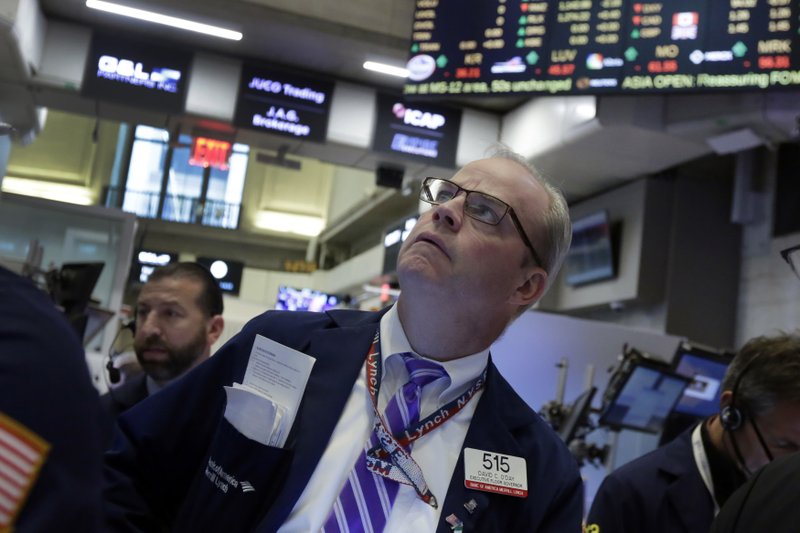NEW YORK -- The first quarter was another weak one on Wall Street, but there are some signs corporate America is coming out of its recent funk.
Earnings at big U.S. companies are on track to tumble 6.4 percent in the first quarter, the worst since the financial crisis. That would also be the third straight decline in profits while revenue is on pace to fall for the fifth quarter in a row.
Much of the blame lies in lower oil prices and a sagging global economy. The beleaguered U.S. energy sector, which includes giants Exxon Mobil and Chevron, is expected to report an overall loss, according to S&P Global Market Intelligence, something that hasn't happened since the firm began collecting data in 1999.
On the economic front, the news remains dour. The International Monetary Fund and World Bank have downgraded their outlook for global growth this year. Growth in the Chinese economy, the world's second-largest and a major driver of growth in other nations, has been slowing steadily since 2010.
"The continued narrative is that the global economy is not very strong, even if the U.S. is the best of the bunch," said Joe Bell, a Cincinnati-based senior equity analyst at Schaeffer's Investment Research Inc.
A stronger dollar has also been hurting big U.S. companies that do a lot of sales in overseas markets. Revenue from goods those companies sell overseas, be it mining equipment, medicines or appliances, is worth less in dollars once the profits are converted back to U.S. currency.
The Standard & Poor's 500 fell 18.06, or 0.9 percent, to end the day Tuesday at 2,063.43, falling for the third time in four days. The Dow Jones industrial average fell 140.25 points to 17,750.91.
"Things had calmed down for the U.S. in March and April and now we're in a mode where the market can't make up its mind and is slipping back and forth," said Peter Jankovskis, who helps oversee $1.9 billion as co-chief investment officer of Lisle, Ill.-based OakBrook Investments.
So what is there to feel good about? Experts think the problems plaguing profits at U.S. companies are starting to fade. With more than two-thirds of the companies in the S&P 500 index having turned in their results, some are seeing positive signs.
"There are little shades of hope," said Lindsey Bell, an analyst for S&P Global Market Intelligence. "It's just very, very early stages."
Giant consumer companies such as Amazon and drug companies such as Pfizer have turned in strong results this quarter. Overall, about 70 percent of companies have reported better-than-expected earnings for the first quarter.
And since investors weren't expecting good results in the first quarter to begin with, they're more focused on what companies are saying about the months ahead. And in many cases, they like what they are hearing. Oil prices have bounced back a little bit over the past three months and, after years of strength, the dollar has slipped.
Bell of S&P Global Market Intelligence adds that some companies think the weaker dollar will bolster their profits in the next few quarters. Pfizer, she said, raised its outlook in part because of the weakening dollar. Chemicals maker DuPont and the giant health care company Johnson & Johnson also issued higher forecasts.
Despite weakness in China and Europe, the U.S. economy kept growing and employers are still hiring large numbers of workers. Jeremy Zirin, chief equity strategist at UBS Wealth Management Americas, noted that makers of machinery and consumer companies are doing especially well, a good sign for the overall health of the U.S. economy.
Analysts think earnings will fall again in the second quarter and then start growing after that. That's partly because the bar has gone so much lower. But it's also because energy prices seem to be recovering and there are hopes that the U.S. economy will continue to grow even if the rest of the world isn't as strong. Last week the government estimated that the U.S. economy expanded at a rate of 0.5 percent in the first three months of the year.
Analysts still project an 8.2 percent decline in first-quarter earnings for the S&P 500 companies. Predictions call for a 4.8 percent drop in the current quarter, compared with forecasts for 3.7 percent growth when the year started.
As for oil, it cost around $100 a barrel in mid-2014 and plunged for more than a year after that, reaching $26 a barrel in February.
It's since recovered to more than $40 a barrel, giving a little relief to energy companies. Oil tumbled to below $44 a barrel on Tuesday ahead of U.S. government data forecast to show nationwide crude supplies rose last week.
West Texas Intermediate crude for June delivery dropped $1.13 to settle Tuesday at $43.65 a barrel on the New York Mercantile Exchange after falling to as low as $43.32 a barrel.
"The price of crude got ahead of itself," said Michael Corcelli, chief investment officer of hedge fund Alexander Alternative Capital in Miami. "The supply issue is definitely there. That's not something that is going to change. Now people are starting to get worried about demand."
Add it all up -- including the uncertainty in the oil market -- and it could mean that 2016 might not be a total wash for corporate profits. S&P Global Market Intelligence said analysts think overall profit growth will eke out a gain of 0.1 percent for the full year.
Information for this article was contributed by Marley Jay of The Associated Press and Joseph Ciolli, Dani Burger and Jessica Summers of Bloomberg News.
A Section on 05/04/2016
